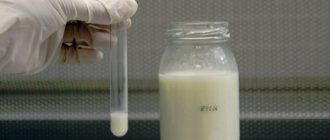pharmachologic effect
Fluconazole is a powerful chemical that suppresses the production of enzymes necessary for the reproduction and functioning of fungal microflora. The drug is active against pathogens of the Candida species. They are common in women and cause candidiasis (thrush) during breastfeeding.
When taken orally, the substance quickly penetrates the blood plasma and spreads throughout the body.
After the first use, women feel relief, the severity of symptoms of candidiasis such as itching, burning, and discomfort subsides. During the first day, discharge is noticeably reduced.
Contraindications for nursing mothers
In the official instructions for the use of Fluconazole, lactation is a contraindication for prescribing it to a woman.
No studies have been conducted on the effect of the drug on the baby's body during breastfeeding. The lack of sufficient clinical experience with the use of the drug during breastfeeding does not allow it to be prescribed during this period.
When taken orally, the concentration of the active substance in breast milk is the same as in the mother's blood. It is enough to compare the weight of mother and child: if a woman drinks 150 mg of the drug, the baby will receive a ten times larger dose (per unit of body weight) with milk.
Even in adults, Fluconazole produces life-threatening side effects (convulsions, changes in heart rhythm, hepatonecrosis), and it is impossible to predict how the medication will affect a newborn.
Can it be used during the lactation period?
An oral antifungal agent is prescribed only if there is no alternative treatment, or if local therapy has not given a positive result.
Effect on lactation
When taken orally, the active substance passes into breast milk. Its concentration is slightly lower than in blood plasma. However, the amount of fluconazole in milk is sufficient to cause toxic effects on the newborn.
According to the official instructions, the drug negatively affects the body of infants and children under 5 years of age.
A single dose of the capsule is allowed. If long-term treatment is required, it is better to stop breastfeeding and transfer the child to artificial feeding.
Impact on infants
In infants, Fluconazole causes the following reactions:
- loss of appetite, nausea, frequent regurgitation;
- bloating, colic;
- disturbance of sleep and wakefulness.

If a woman takes the drug for a long time and is breastfeeding her baby, signs of the negative effect of the substance on the body are slow weight gain and retardation in physical development. There is a weak sucking reflex or breast refusal. Because of colic, the baby often cries, is capricious, and has trouble falling asleep.
How to use Fluconazole while breastfeeding

Fluconazole passes into mother's milk in a dosage slightly lower than that found in blood plasma.
According to the decision of the Ministry of Health, during lactation, a single use of the drug in an amount of 200 mg/day or less is allowed without risk to the child. The dosage and form of administration of the drug to a nursing mother is prescribed by a doctor.
In case of severe pathology and long-term treatment with high dosages, it is recommended to interrupt breastfeeding. [1, p. 8]
Expert opinion
Sokolova L. S.
Pediatrician of the highest category
A distinctive feature of the drug is its long-lasting effect. The active substance remains in the patient’s blood for 3-4 days. Therefore, a single dose of Fluconazole is usually sufficient to treat a lactating woman.
Recommendations for the use of Fluconazole for hepatitis B
A nursing mother who is prescribed Fluconazole should take the medicine immediately before feeding the baby. It takes some time for the drug to be absorbed into the blood and enter breast milk, which will be enough to feed the baby. The break until the next feeding should be extended, if possible, so that the drug is at least partially excreted from the body by the kidneys [2].
In what cases is medication prescribed?
The main indication for the use of Fluconazole is vaginal candidiasis. More than 90% of women develop a fungal infection due to weakened immunity. To maintain the possibility of breastfeeding and not harm the baby, local treatment is prescribed - antifungal suppositories. If there is no improvement within one course (7-10 days), Fluconazole is prescribed in capsules for systemic use (orally).
The drug helps with cryptococcosis, candidiasis of various mucous membranes and organs, and mycoses.
Is it possible to combine the drug with other medications?
If, in addition to the fungus, a woman’s body has concomitant diseases in the chronic stage, she has to take several medications at the same time. Therefore, it is worth understanding how Fluconazole interacts with other drugs.
For example, this drug cannot be used together with Erythromycin or Terfenadine, since their combined use has a toxic effect on the heart muscle, causing arrhythmia.
Diuretics promote excessive release of fluid, while the concentration of the fungicide in the blood serum increases, which can lead to the same consequences as with an overdose.
Amitriptyline, when taken together with Fluconazole, increases the effect of therapy, but sometimes it is necessary to adjust the dose or dosage regimen.
Anticoagulants, when taken together, can change their effect and affect the body in an enhanced manner, and this can lead to the formation of hematomas or bleeding.

In conclusion, we can say that not all antifungal drugs are approved during lactation. Therefore, only a doctor should prescribe each remedy, based on the patient’s complete medical history and seeing the whole picture of what is happening.
Dosage and instructions for use
In most cases, a single dose of the drug relieves the symptoms of thrush. One capsule is enough to relieve redness, inflammation of the vaginal mucosa, itching, and pathological discharge.

The dosage of Fluconazole during breastfeeding is determined by the gynecologist. A single dose should not exceed 200 mg. You can continue feeding with this dosage; it will not harm the baby. If repeated use and long-term therapy are necessary, breastfeeding is canceled and the baby is transferred to infant formula.
Fluconazole during lactation
There have been no studies that have examined the effect of the drug during breastfeeding. However, the drug is known to penetrate into all body fluids, including blood and breast milk.
The product that passes into milk also enters the baby's body during breastfeeding. This can lead to colic and allergies in the baby, and in the worst case, to poisoning and developmental arrest.
The concentration of Fluconazole in breast milk is equal to the level in plasma. Therefore, it is not recommended to take this remedy during lactation. Doctors rarely prescribe the drug to nursing mothers.
Taking 150 milligrams is considered safe for an infant. However, many experts recommend that even when taking such a small dose, you should stop breastfeeding for a week. When taking large doses, breastfeeding must be stopped.
Dosage during lactation and alternative means
| Type of infection | Dosage of the drug Fluconazole | Alternative medicines without interrupting breastfeeding |
| Genital thrush | 150 mg once | Pimafucin suppositories, Nystatin ointment |
| Intestinal thrush | the first three days - 400 mg; then - 200 mg | Pimafucin tablets |
| Oral thrush | 100 mg per day for one to two weeks | Pimafucin tablets, rinsing with soda solution |
| Fungal infection of internal organs | 600-800 mg per day | suppositories Pimafucin and Livarol |
| External fungal infection (fungus on the skin) | not prescribed during lactation | Triderm and Pimafucort ointments (before feeding, you must wash off the ointment!) |
During breastfeeding, the best remedy for fungal infections are suppositories that are not absorbed into the blood. These include Pimafucin. That is why this drug is often recommended for nursing mothers.
Before using any medications, be sure to consult your doctor!
A safe and effective remedy for fungal disease is diet. It involves reducing the consumption of sugar and starch, flour products. It is necessary to reduce the intake of green and black tea. Fermented milk products, especially cottage cheese and kefir, will be of great benefit.

Interaction with other drugs
The antifungal agent cannot be combined with antipsychotics, anticonvulsants, and antituberculosis drugs. These are serious drugs, most of which are narcotic, and can only be purchased with a doctor's prescription. There is no need to consider them in the context of interaction with Fluconazole during breastfeeding, since their prescription automatically excludes breastfeeding. Of the drugs allowed for hepatitis B, Fluconazole cannot be used simultaneously with antibiotics and non-steroidal anti-inflammatory drugs - Paracetamol, Ibuprofen.
Interaction with other drugs
With concomitant chronic diseases, the patient has to take several medications at the same time. It is important to know how medications affect each other.
The mixed use of Fluconazole with Terfenadine or Erythromycin has a toxic effect on the heart muscle with the occurrence of arrhythmias. These medications should not be used together.
Diuretics lead to increased secretion of fluid from the body, the concentration of the fungicide in the blood serum increases, and symptoms of overdose are possible. Antidepressants (Amitriptyline) together with Fluconazole increase the therapeutic effect; sometimes adjustments in doses and treatment regimens are required.
Anticoagulants increase their effect in the presence of the drug: bleeding and hematoma formation are possible.
Analogues of the drug
The pharmaceutical industry has chemical-based antifungals with a similar effect.

Pharmacy drugs
Names of topical medications (vaginal suppositories):
- Clotrimazole;
- Livarol;
- Nystatin;
- Betadine;
- Terzhinan;
- Zalain;
- Pimafucin.
Analogues for oral administration: Diflucan, Diaflu, Kandizol, Mikomax, Fluzamed, Fluconaz.
Folk remedies for thrush
Plant herbs are effective against thrush symptoms. They are used in the form of a decoction for douching and oral administration. Prescribed medicinal plants: knotweed, chamomile, birch buds, juniper, nettle, oak bark, St. John's wort. They are used both separately and as a medicinal collection.
Composition, release form and pharmacological action
The main component of the drug is considered to be the substance of the same name fluconazole, one of the triazole derivatives (a highly effective antifungal agent). The product is produced in several variations, these are tablets or capsules and a solution for oral administration in the form of injections:
- There are packages of the drug with different concentrations, from 50 to 150 mg, the composition of the product varies slightly depending on the manufacturer.
- The solution is produced with the following concentration of the active component: 200 mg per 100 ml is recommended.
The pharmacological effect is due to an obstacle to the proliferation of fungal enzymes of protein origin, which in turn increases the permeability of the cell membrane, inhibits their spread, and then completely eliminates pathogenic microbes. Almost all pathogens of fungal diseases are sensitive to Fluconazole.
The product dissolves well and is absorbed in the body, despite taking the medicine even with meals. Fluconazole is rapidly absorbed and reaches its maximum concentration 4 hours after administration.
The active substance is distributed throughout the body in different proportions; saliva, vaginal secretions, sputum, breast milk or fluid around the joints contain the same percentage of the substance as plasma. Most, 90%, enters the spinal fluid, the epidermis, stratum corneum and sweat accumulate a larger amount of the active component than blood serum. Half-life products are formed within 30 hours and are excreted in the urine.











